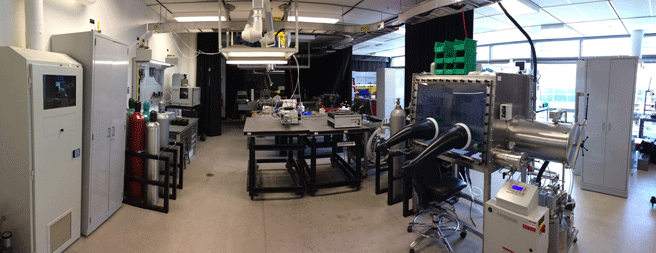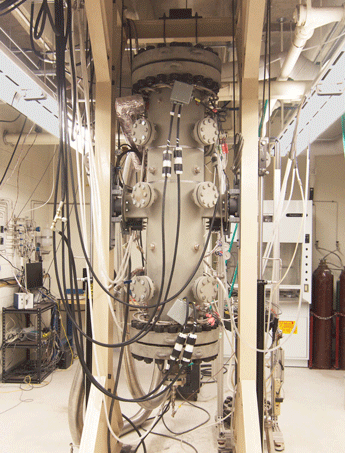Facilities
Optical Diagnostics Laboratory
 The Optical Diagnostics Laboratory is a 2100-square-foot facility located in Brown Building on the Mines campus in Golden, Colorado. This laboratory houses laser diagnostic equipment, optical tables, burners, combustion chambers, furnaces, fuel injection pressure vessels, pulsed and short-pulsed lasers, as well as a host of spectrometers, detectors, optics, and other laser sources. The lab contains chemical hoods, liquid and gas storage, a wet lab, and a controlled low humidity and oxygen glove box.
The Optical Diagnostics Laboratory is a 2100-square-foot facility located in Brown Building on the Mines campus in Golden, Colorado. This laboratory houses laser diagnostic equipment, optical tables, burners, combustion chambers, furnaces, fuel injection pressure vessels, pulsed and short-pulsed lasers, as well as a host of spectrometers, detectors, optics, and other laser sources. The lab contains chemical hoods, liquid and gas storage, a wet lab, and a controlled low humidity and oxygen glove box.
Analytical equipment in the lab includes Keithley picoammeter/voltage supply, gas chromatography, micro GC, mass spectrometer, and a potentiostat/galvanostat. High-speed data acquisition equipment includes a National Instruments 8 simultaneous analog input, 2 MS/s/ch, DAQ with 16-bit resolution, and a Gage CobraMax 4 GS/s, 2-channel, 8 bit digitizer.
Optical sources in the lab include: Continuum Nd:Yag Leopard picosecond pulsed laser, Nd:Yag nanosecond pulsed laser, Nd:Yag CW laser, CO2 CW laser, HeNe laser (IR & Vis), Argon-Ion laser CW, deuterium, halogen, tungsten, and xenon lamps. Several research-grade cameras are available in the lab, as well as a host of optical detectors, optics and filters. A large number of optical cells are available in the lab included a heated liquid cell (25 °C to 200 °C), variable pathlength liquid cells (KBr, CaF2, UV quartz windows), long pathlength gas cells, and high pressure optical cells. Optical diagnostic capabilities include: ballistic imaging, raman spectroscopy, FTIR spectroscopy (gases and liquids), UV/VIS spectroscopy, LIF, PLIF, Mie scattering for droplet size, spray imaging, laser induced breakdown spectroscopy (LIBS), tunable diode laser absorption spectroscopy, and cavity ringdown absorption spectroscopy.
High-Pressure Flow Reactor Laboratory
 The high-pressure entrained-flow reactor is a laboratory-scale research vessel designed for coal, biomass, and solid waste gasification or combustion. The reactor can reach a temperature of 1650 °C and pressures to 50 atm. At the heart of the reactor is a 1m long, 5cm diameter silicon carbide heated tube. There are four heating zones along the length of the reactor providing uniform heating of the SiC tube.
The high-pressure entrained-flow reactor is a laboratory-scale research vessel designed for coal, biomass, and solid waste gasification or combustion. The reactor can reach a temperature of 1650 °C and pressures to 50 atm. At the heart of the reactor is a 1m long, 5cm diameter silicon carbide heated tube. There are four heating zones along the length of the reactor providing uniform heating of the SiC tube.
The gasifier is equipped for solid (fine particulates), liquid, or gas injection. The gasifier is capable of co-injecting steam, oxygen, and other gases with liquid or solid feedstocks. Gases are extracted from the bottom of the reactor and analyzed using gas chromatography and FTIR spectrometry. Unreacted particles are filtered from the exhaust stream for characterization and determining carbon balance. The gasifier facility also includes equipment for grinding, sieving, and injecting fine particulates.
The gasifier is ideal for characterizing carbonaceous materials for gasification, testing syngas processing technologies (e.g., hydrogen separation and sulfur removal), and studying gasification kinetics. The compact size of the reactor reduces operating costs and allows for rapid testing of diverse feedstocks over a large range of operating conditions. In addition, the reactor is suitable for demonstrating optical diagnostics in the harsh environment typical of gasification.